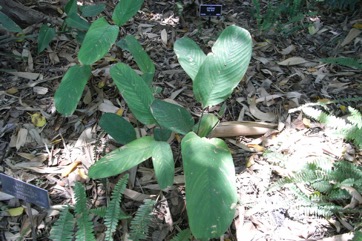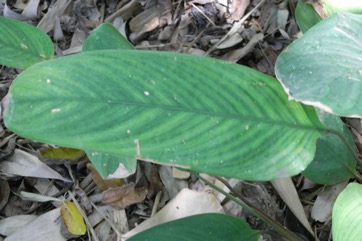West Indian Arrowroot

It is a tropical plant. It grows well in hot humid climates. A temperature of 20-30°C is best. Plants grow from the coast up to 900 m altitude in the tropics. It needs a rainfall of 1500 to 2000 mm yearly. It is cultivated in S China for starch. It needs deep, well drained and slightly acid soil. It suits plant hardiness zones 10-12. Bontoc. In Yunnan.
Also known as:
Ai-raruut, Aloro, Amaranta, Angkrik, Ango, Araluk, Araratu, Araru, Ararut, Araruttukkilangu, Aroro, Aroro, Arrowroot, Aruruttukkilangu, Bermuda arrowroot, Berolu, Choc-u, Chok-woo, Chuk shway, Garut, Hnathel, Hoangting, Hpogimbai, Hulakiriya, Khaita alu, Koova, Kuvamavu, Kuvehittu, Kuzu ukon, Larut, Maranta, Midon, Misimisi koka'anga, Nginti ali, Palaguntha, Patat sagu, Pikaw, Saakhu, Sagu belanda, Saku, Taros metan, Tavaksha, Tavkil, Tha lairusa, Thinbaw-adalut, Tikhor, Tora alu, Ubi garut, Yuquilla
Synonyms
- Maranta sylvatica Roscoe ex Smith
- Phyrnium variegatum N.E.Brown
Edible Portion
- Rhizome, Root, Vegetable
Where does West Indian Arrowroot grow?
Found in: Africa, Asia, Australia, Bangladesh, Barbados, Brazil, Cambodia, Caribbean, Central Africa, Central America, China, Congo DR, Costa Rica, Cuba, Dominica, East Timor, Ecuador, Fiji, French Guiana, Grenada, Guam, Guatemala, Guianas, Guyana, Hawaii, India, Indochina, Indonesia, Jamaica, Japan, Malaysia, Mexico, Myanmar, North America, Northeastern India, Pacific, Papua New Guinea, PNG, Peru, Philippines, Puerto Rico, Sao Tome and Principe, SE Asia, Sierra Leone, Singapore, Solomon Islands, South Africa, Southern Africa, South America, Sri Lanka, St. Vincent and Grenadines, Suriname, Taiwan, Thailand, Timor-Leste, Tonga, United States, Vanuatu, Venezuela, Vietnam, West Africa, West Indies
Notes: There are about 32 Maranta species. There are 25 species in tropical America.
Status: It is a commercially cultivated vegetable. It has mostly been grown as an experimental crop in Papua New Guinea, and is probably not widely used by village people.
Growing West Indian Arrowroot
Cultivation: Plants are grown from pieces of rhizome or occasionally suckers. A spacing of 1 m x 0.5 m is suitable or can be closer. 3,000-3500 kg of planting material are required for one hectare. The pieces are planted 6-8 cm deep. It requires a fertile soil. Normally flowers are removed to allow as much storage as possible in the rhizomes.
Edible Uses: The rhizomes are used in soups or sauces. They can be just scraped & boiled. They can be used for making flour. It is an easily digested starchy flour. It is a good thickener in sauces. The fresh rhizomes can be stored for 7-8 days. CAUTION It is important to peel off the skin scales or they give a bitter taste to the starch.
Production: Rhizomes are ready for harvest after about 11 months. Successive crops are grown in the same site for 5-7 years. Yields of 12.5 t per hectare are average. These produce 8-16% starch.
Nutrition Info
per 100g edible portion| Edible Part | Energy (kcal) | Protein (g) | Iron (mg) | Vitamin A (ug) | Vitamin c (mg) | Zinc (mg) | % Water |
|---|---|---|---|---|---|---|---|
| Root starch | 362 | 0.4 | 1.2 | 0 | 0 | - | 12.2 |
| Root - raw | 65 | 4.2 | 2.2 | 2 | 1.9 | 0.6 | 80.8 |
West Indian Arrowroot Photos


References
Ambasta, S.P. (Ed.), 2000, The Useful Plants of India. CSIR India. p 356
Bianchini, F., Corbetta, F., and Pistoia, M., 1975, Fruits of the Earth. Cassell. p 220
Bodkin, F., 1991, Encyclopedia Botanica. Cornstalk publishing, p 675
Bodner, C. C. and Gereau, R. E., 1988, A Contribution to Bontoc Ethnobotany. Economic Botany, 43(2): 307-369
Bremness, L., 1994, Herbs. Collins Eyewitness Handbooks. Harper Collins. p 187
Burkill, H. M., 1985, The useful plants of west tropical Africa, Vol. 4. Kew.
Burkill, I.H., 1966, A Dictionary of the Economic Products of the Malay Peninsula. Ministry of Agriculture and Cooperatives, Kuala Lumpur, Malaysia. Vol 2 (I-Z) p 1447
Cheifetz, A., (ed), 1999, 500 popular vegetables, herbs, fruits and nuts for Australian Gardeners. Random House p 82
Chizmar Fernandez, C., et al, 2009, Plantas comestibles de Centroamerica. Instituto de Biodiversidad, Costa Rica. p 233
Cobley, L.S. (rev. Steele, W.M.) 2nd Ed., 1976, An Introduction to the Botany of Tropical Crops. Longmans. p 126
Cundall, P., (ed.), 2004, Gardening Australia: flora: the gardener's bible. ABC Books. p 874
Dutta, U., 2012, Wild Vegetables collected by the local communities from the Churang reserve of BTD, Assam. International Journal of Science and Advanced Technology. Vol. 2(4) p 122
Facciola, S., 1998, Cornucopia 2: a Source Book of Edible Plants. Kampong Publications, p 149
FAO, 1993, Valor Nutritivo Y Usis en Alimantacion humana de Algunis Cultivos Autoctonos Subexplotados de Mesoamerica. FAO, Santiago, Chile. p 89
French, B.R., 1986, Food Plants of Papua New Guinea, A Compendium. Asia Pacific Science Foundation p 142
French, B.R., 2010, Food Plants of Solomon Islands. A Compendium. Food Plants International Inc. p 39
Gragson, T. L., 1997, The Use of Underground Plant Organs and Its Relation to Habitat Selection among the Pume Indians of Venezuela. Economic Botany, Vol. 51, No. 4, pp. 377-384
Hedrick, U.P., 1919, (Ed.), Sturtevant's edible plants of the world. p 403
Hibbert, M., 2002, The Aussie Plant Finder 2002, Florilegium. p 193
Hu, Shiu-ying, 2005, Food Plants of China. The Chinese University Press. p 330
Jardin, C., 1970, List of Foods Used In Africa, FAO Nutrition Information Document Series No 2.p 18
Kay, D.E., 1973, Root Crops, Digest 2, Tropical Products Institute, London, p 16
Kays, S. J., and Dias, J. C. S., 1995, Common Names of Commercially Cultivated Vegetables of the World in 15 languages. Economic Botany, Vol. 49, No. 2, pp. 115-152
Kiple, K.F. & Ornelas, K.C., (eds), 2000, The Cambridge World History of Food. CUP p 1721
Latham, P., 2004, Useful Plants of Bas-Congo province. Salvation Army & DFID p 182
Lembaga Biologi Nasional, 1977, Ubi-Ubian, Balai Pustaka, Jakarta. p 32
Lim, T. K., 2015, Edible Medicinal and Non Medicinal Plants. Volume 9, Modified Stems, Roots, Bulbs. Springer p 54
Llamas, K.A., 2003, Tropical Flowering Plants. Timber Press. p 272
Macmillan, H.F. (Revised Barlow, H.S., et al) 1991, Tropical Planting and Gardening. Sixth edition. Malayan Nature Society. Kuala Lumpur. p 341
Medhi, P. & Borthakur, S. K., 2012, Phytoresources from North Cachur Hills of Assam -3: Edible plants sold at Hflong market. Indian Journal of Natural Products and Resources. 3(1) pp 84-109
Miguel, E., et al, 1989, A checklist of the cultivated plants of Cuba. Kulturpflanze 37. 1989, 211-357
Morley, B. & Everard, B., 1970, Wild Flowers of the World. Ebury press. Plate 189
Ochse, J.J. et al, 1931, Vegetables of the Dutch East Indies. Asher reprint. p 480
Omawale, 1973, Guyana's edible plants. Guyana University, Georgetown p 79
Patiri, B. & Borah, A., 2007, Wild Edible Plants of Assam. Geethaki Publishers. p 143
Phon, P., 2000, Plants used in Cambodia. © Pauline Dy Phon, Phnom Penh, Cambodia. p 429
Purseglove, J.W., 1972, Tropical Crops. Monocotyledons. Longmans p 336
Rajapaksha, U., 1998, Traditional Food Plants in Sri Lanka. HARTI, Sri Lanka. p 295
Recher, P, 2001, Fruit Spirit Botanical Gardens Plant Index. www.nrg.com.au/~recher/ seedlist.html p 2
Sharma, B.B., 2005, Growing fruits and vegetables. Publications Division. Ministry of Information and broadcasting. India. p 231
Smith, A.C., 1979, Flora Vitiensis Nova, Lawaii, Kuai, Hawaii, Volume 1 p 218
Smith, N., Mori, S.A., et al, 2004, Flowering Plants of the Neotropics. Princeton. p 459
Smith, P.M., 1979, Arrowroot, in Simmonds, N.W., (ed), Crop Plant Evolution. Longmans. London. p 316
Solomon, C., 2001, Encyclopedia of Asian Food. New Holland. p 158
Sp. pl. 1:2. 1753
Staples, G.W. and Herbst, D.R., 2005, A tropical Garden Flora. Bishop Museum Press, Honolulu, Hawaii. p 705
Sukarya, D. G., (Ed.) 2013, 3,500 Plant Species of the Botanic Gardens of Indonesia. LIPI p 1123
Terra, G.J.A., 1973, Tropical Vegetables. Communication 54e Royal Tropical Institute, Amsterdam, p 57
Thaman, R.R., 1976, The Tongan Agricultural System, University of the South Pacific, Suva, Fiji. p 410
Tutul, E et al, 2009, Angiospermic Flora of Runctia Sal Forest, Bangladesh. Bangladesh J. Plant Taxon. 16(1): 83-90. p 86
van Wyk, B., 2005, Food Plants of the World. An illustrated guide. Timber press. p 386
Walter, A. & Lebot, V., 2007, Gardens of Oceania. ACIAR Monograph No. 122. CD-ROM minor species p 2
Williams, C.N., Chew, W.Y., and Rajaratnam, J.A., 1989, Tree and Field Crops of the Wetter Regions of the Tropics. Longman, p 216
World Checklist of Useful Plant Species 2020. Royal Botanic Gardens, Kew
Yuncker, T.G., 1959, Plants of Tonga, Bernice P. Bishop Museum, Hawaii, Bulletin 220. p 86